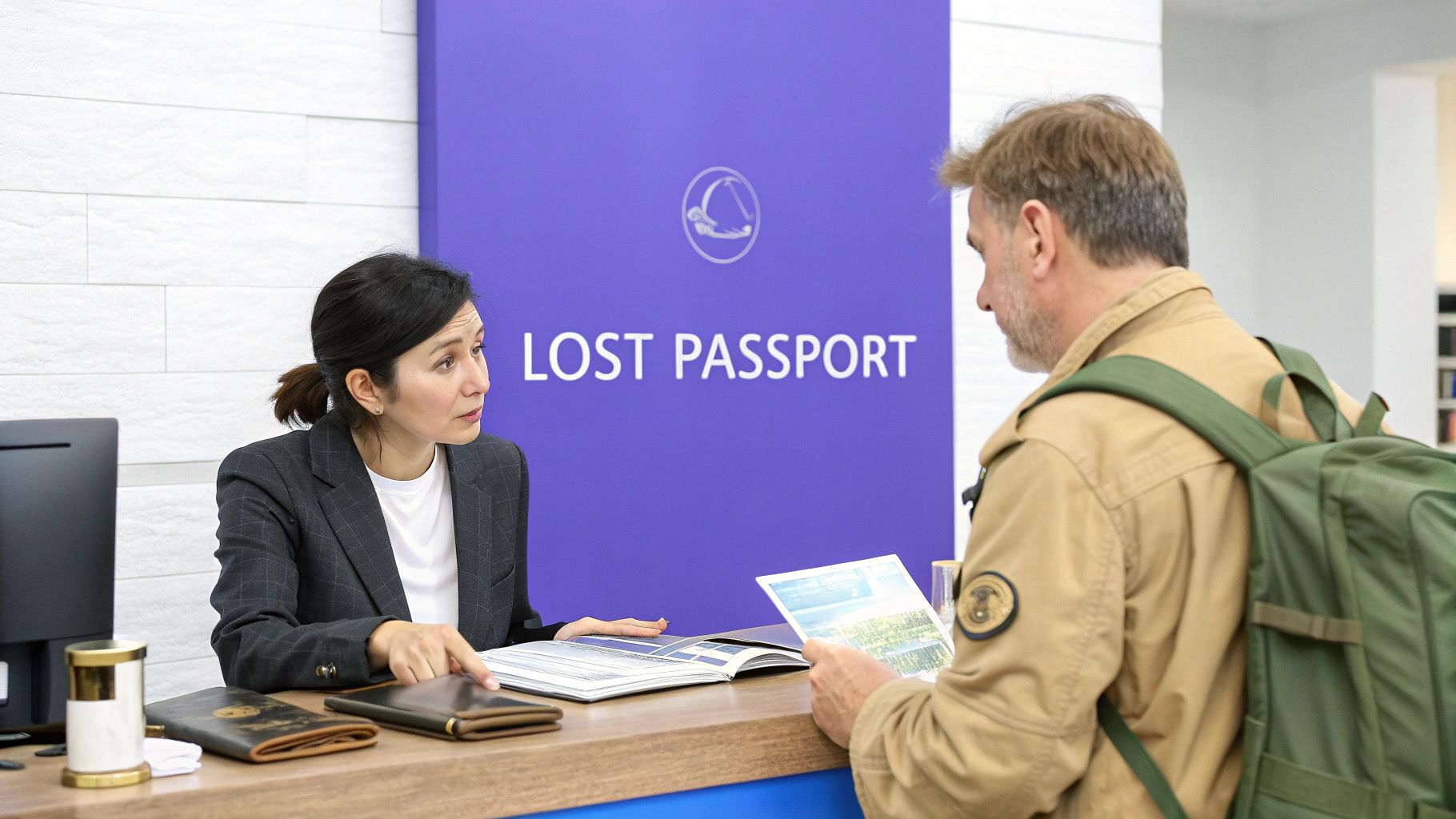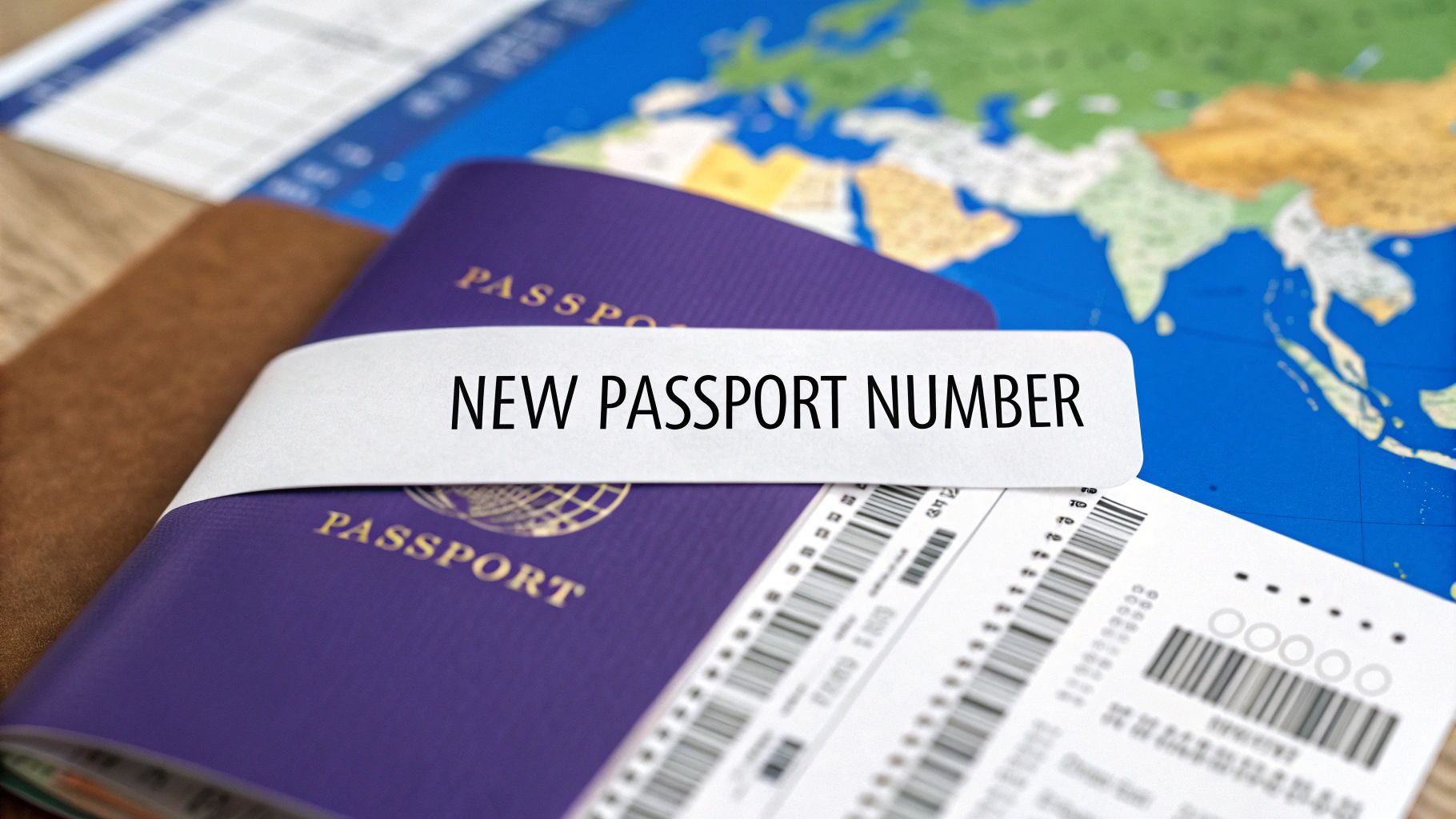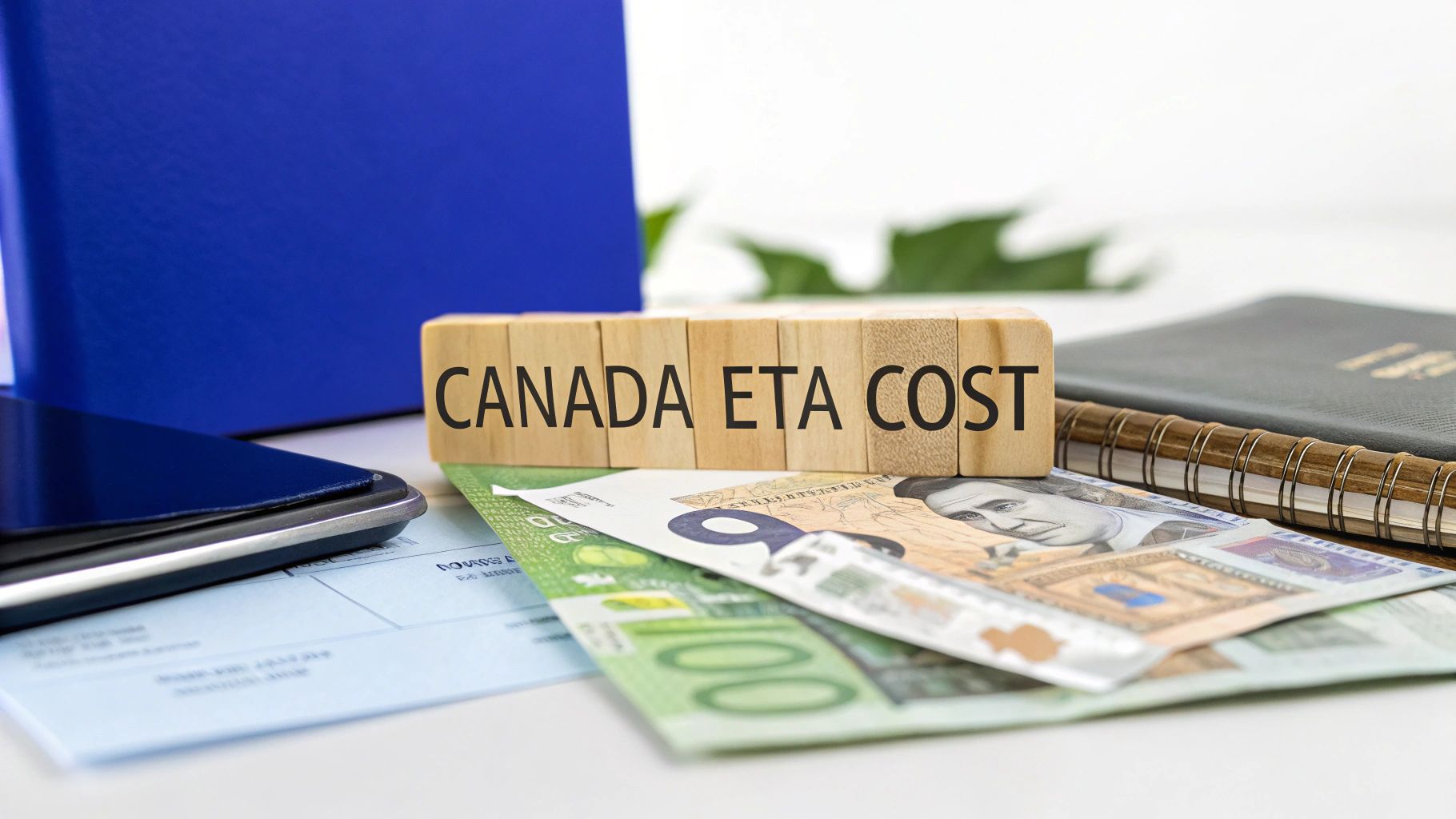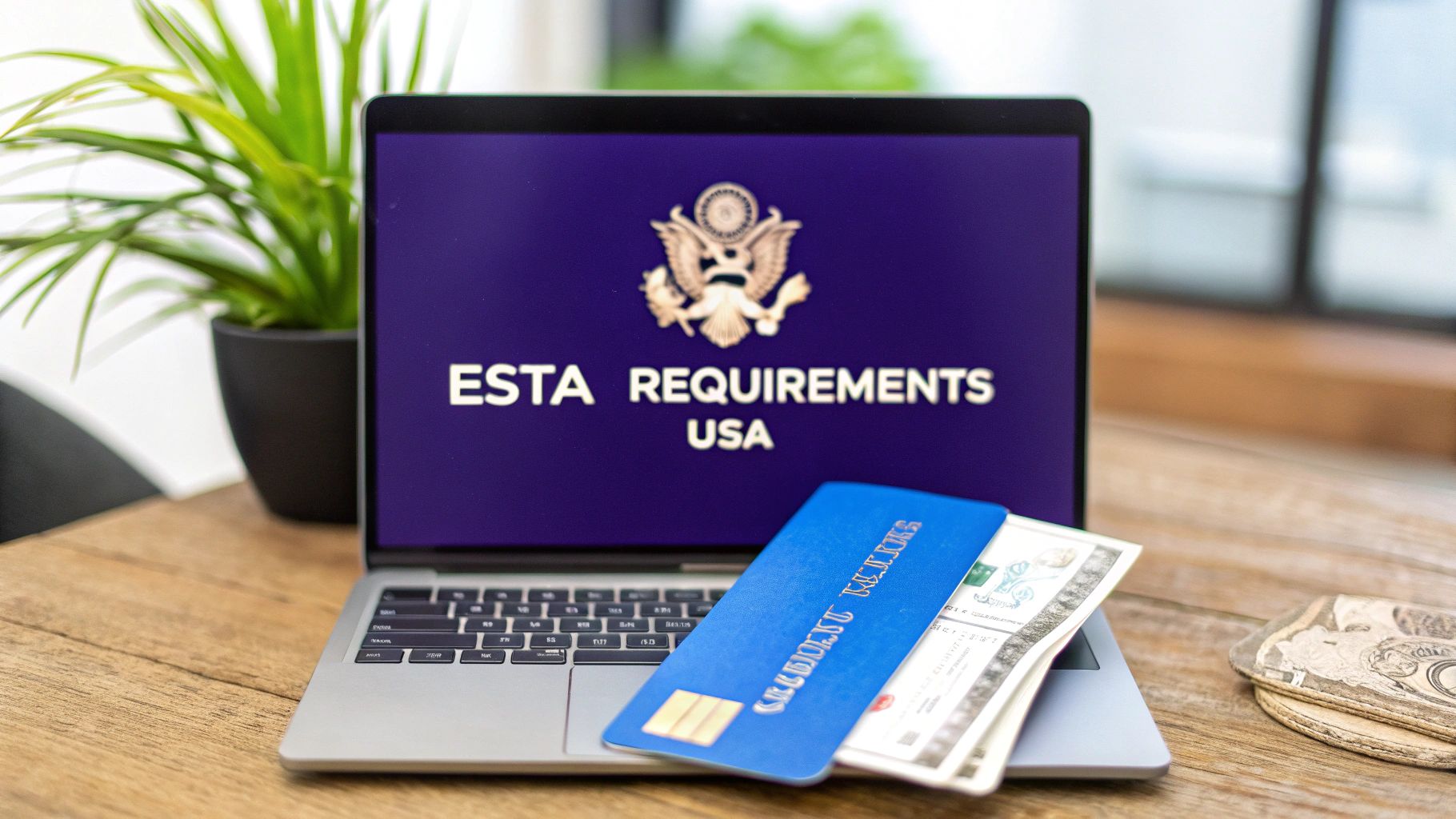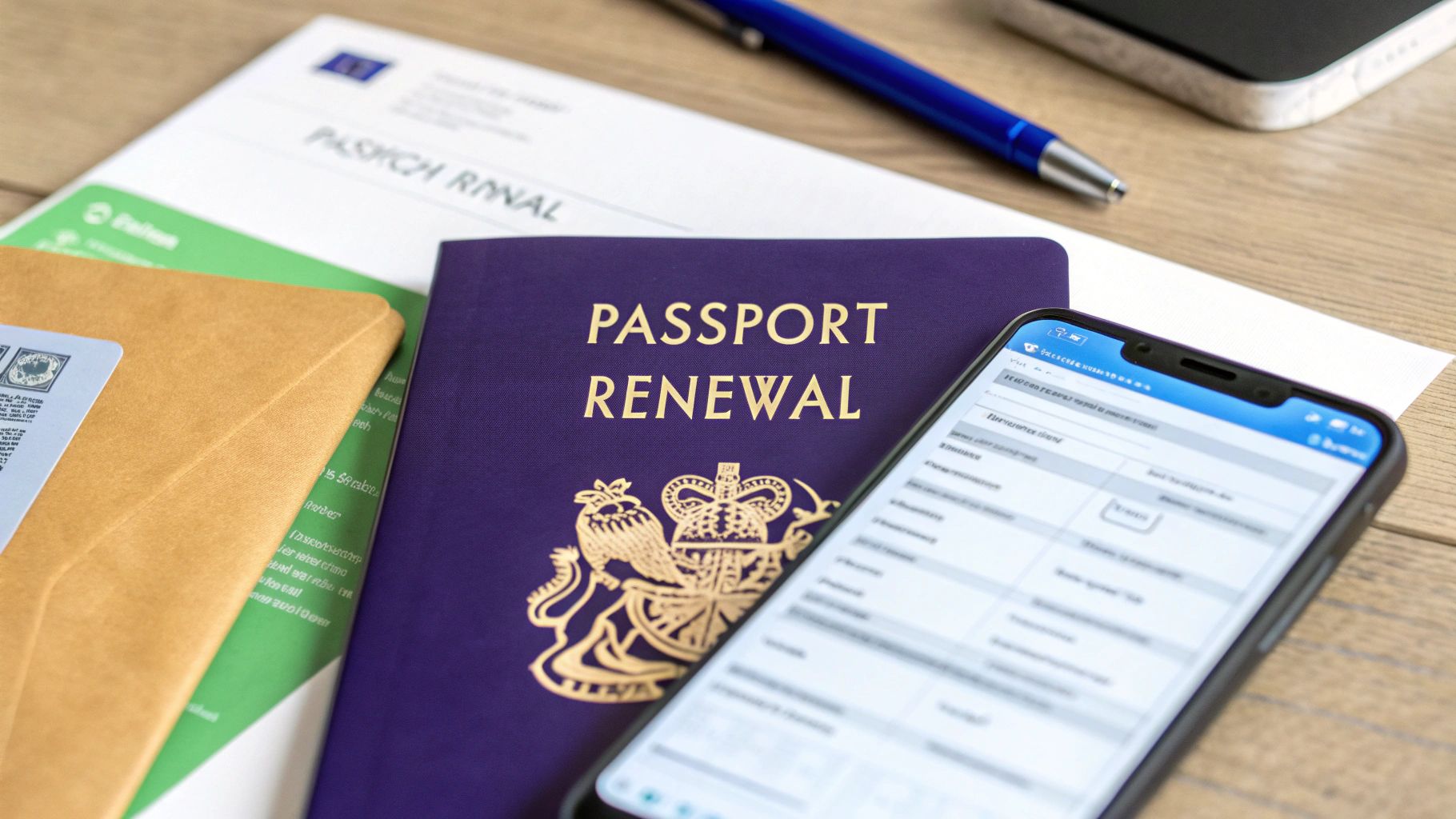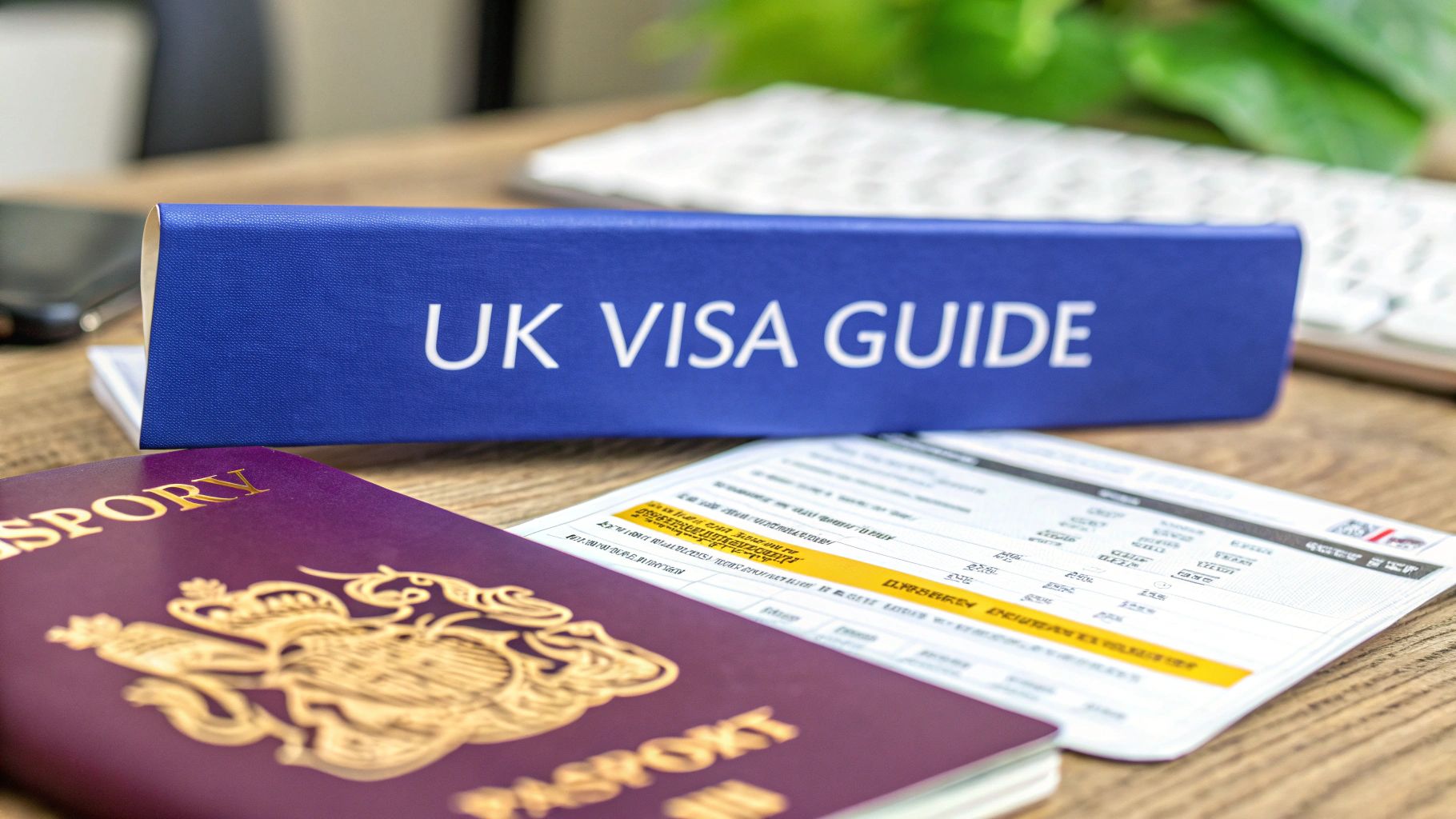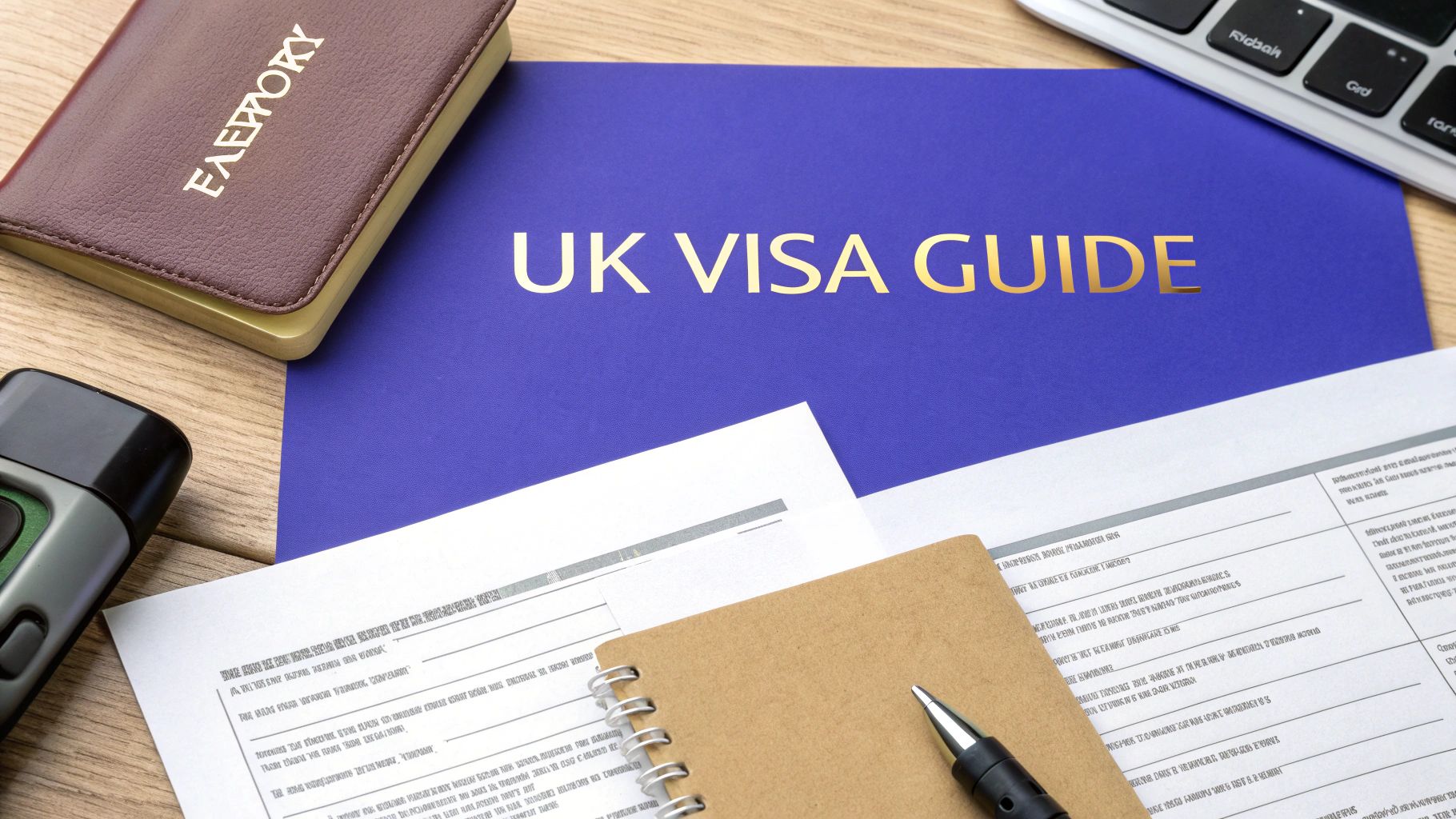
How to Apply for a Visa to England: A Practical Guide
Before you even think about booking flights or packing your bags for England, there’s one critical first step: figuring out exactly what kind of entry permission you need.
It all boils down to your nationality, how long you're staying, and why you're visiting. The two main paths are the Standard Visitor Visa and the newer UK Electronic Travel Authorisation (ETA). Getting this right from the start is genuinely the most important part of the whole process.
Determining Your UK Entry Requirements
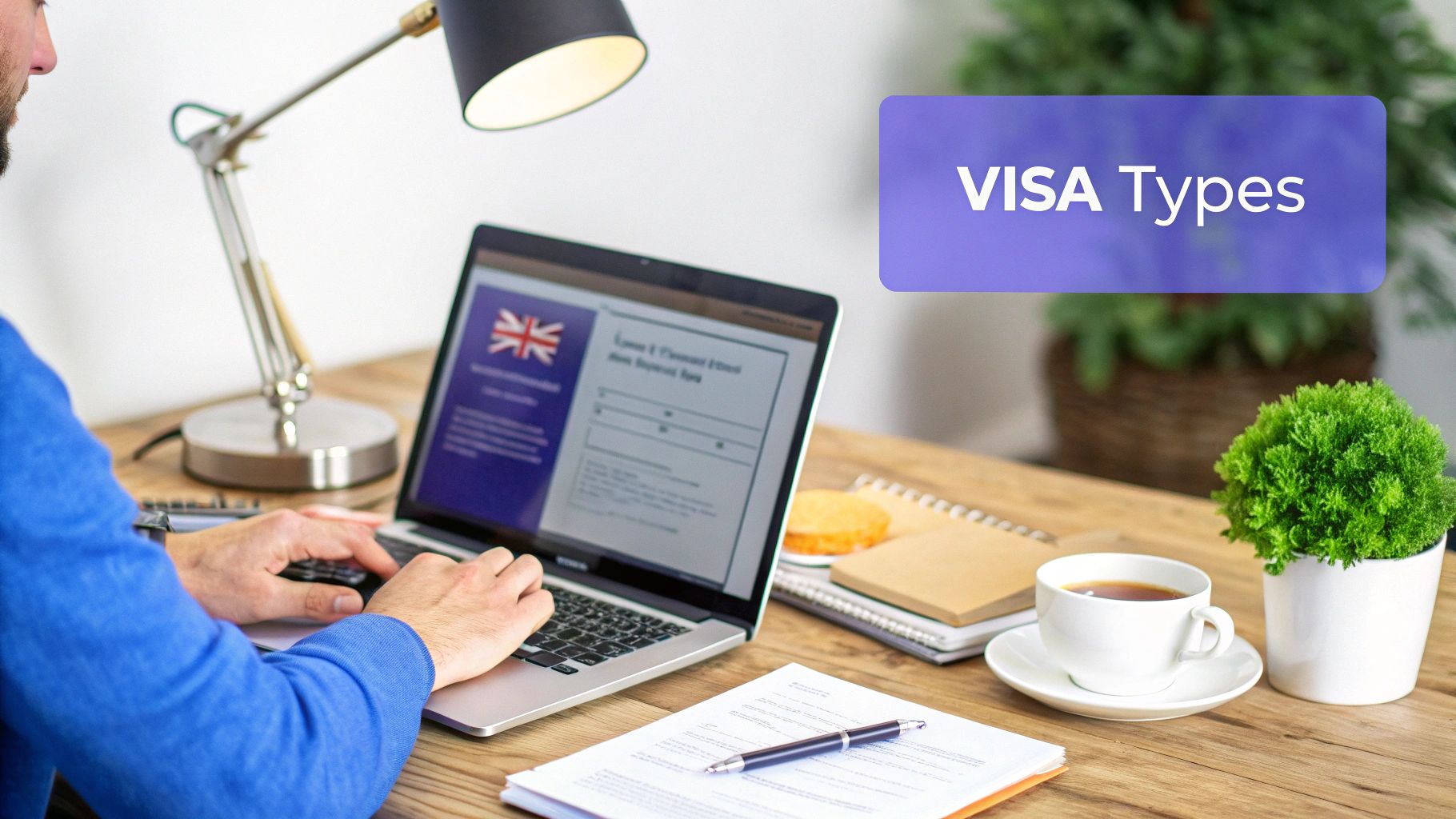
So, where do you begin? The UK government has very specific rules based on your passport and your travel plans. A simple mistake here—applying for an ETA when you need a visa, for instance—can mean being turned away at the airport, losing your application fees, and facing major headaches.
The key difference comes down to whether you're a "visa-national" or a "non-visa national."
If you’re a visa-national, you’ll always need to apply for a formal visa ahead of time, no matter how short your trip is.
But if you're a non-visa national—which includes citizens from places like the USA, Australia, and all EU countries—you've historically been able to visit for up to six months without a visa. That's changing.
The Rise of the UK ETA
The system for non-visa nationals is being updated with the Electronic Travel Authorisation (ETA) program. It's a digital pre-clearance system that’s becoming mandatory for travel authorization for the UK.
This means even if your country has always enjoyed visa-free travel to the UK, you will soon need to apply for a UK ETA online before you fly.
Let's be clear: an ETA is not a visa. Think of it as a digital green light to travel. It's designed for short-term stays, like:
- Tourism: Holidays, visiting family, or just seeing the sights.
- Short-Term Business: Attending a conference or meeting.
- Transit: Just passing through a UK airport on your way somewhere else.
- Short-Term Study: Taking a course that lasts less than six months.
For example, an American planning a two-week London holiday will need a UK ETA, not a visa. Same for a Canadian professional heading to a three-day summit in Manchester.
The UK's ETA is a digital permission to travel, authorising a person to travel to the UK, but it is not a visa and does not permit entry on its own. It's a critical pre-travel check that enhances border security.
When a Standard Visitor Visa Is Necessary
So, when do you need to go through the full visa application process? A formal Standard Visitor Visa is mandatory if:
- Your nationality isn't on the UK's visa-waiver or ETA-eligible list.
- You want to stay for longer than six months.
- Your reason for visiting isn't covered by an ETA (e.g., long-term study, paid work, or getting married).
Imagine a software developer from India who lands an eight-month contract in London. Even though the work is temporary, the stay is longer than six months, so they'd need a proper work visa—not a visitor visa or an ETA.
To help you navigate this, here's a quick cheat sheet.
UK Entry Requirements At a Glance
This table should give you a quick idea of whether you'll likely need a visa or a UK ETA.
| Traveler Profile | Likely Requirement | Key Considerations |
|---|---|---|
| US/EU citizen on a 2-week holiday | UK ETA | Your stay is short-term and for tourism. |
| Indian citizen visiting for 8 months | Visa (likely a Work or Long-Term Study Visa) | Your stay exceeds the 6-month visitor limit. |
| Australian transiting through Heathrow | UK ETA | Even for transit, ETA is now required for eligible nationalities. |
| South African citizen on a 3-month family visit | Standard Visitor Visa | South Africa is a visa-national country. |
| Canadian attending a 1-week conference | UK ETA | This falls under short-term business activities. |
Ultimately, your passport and your travel itinerary are the two pieces of the puzzle that solve this initial question.
For a deeper dive into specific scenarios, you can learn more about travel to UK visa requirements in our complete guide. Always double-check the latest rules on the official government website before you book anything. Nailing this first step sets you up for a smooth and successful application.
UK Visa vs. ETA: Which One Do You Actually Need?
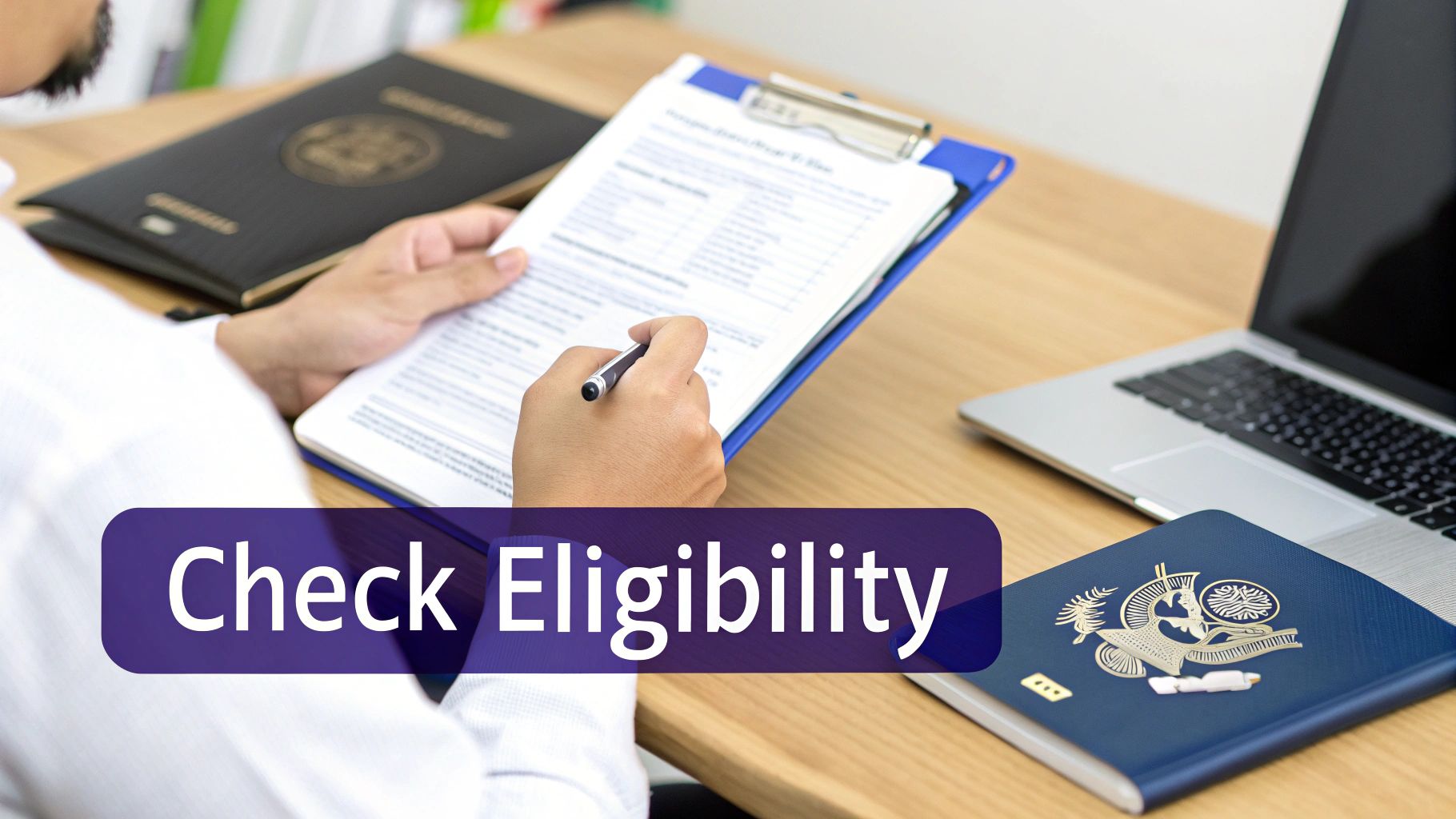
Navigating UK entry requirements can feel like you’re at a fork in the road. One path is the traditional visa route, and the other is the newer, streamlined UK Electronic Travel Authorisation (ETA). Picking the wrong one can bring your travel plans to a halt.
The choice comes down to just two things: your nationality and the reason for your trip. It's that simple, but getting it right is absolutely critical.
UK immigration policies are constantly evolving, which directly affects how applications are handled. For example, recent changes to salary thresholds caused a drop in Skilled Worker visa applications, while stricter compliance checks led to a sharp decline in Health and Care Worker visas. These trends highlight why staying informed is so important.
When You Have No Choice But a Standard Visitor Visa
The Standard Visitor Visa is the more involved of the two options. It's a formal process that requires a detailed application, submitting your biometric data, and sometimes attending an interview.
You'll need to go down this route if any of these apply to you:
- Your passport is from a "visa-national" country that doesn't have a visa-waiver agreement with the UK.
- You plan to stay longer than six consecutive months.
- Your trip's purpose isn't covered by standard visitor rules, like getting married, long-term study, or doing any kind of paid or unpaid work.
For example, a freelance graphic designer from a visa-national country wanting to spend a few months in Manchester to work on personal projects would need a Standard Visitor Visa. Even though their purpose is tourism-adjacent, their nationality makes the visa mandatory.
Getting to Know the UK ETA
The UK Electronic Travel Authorisation (ETA) is a game-changer for visitors who previously didn't need a visa to enter the UK. Think of it as a digital permission slip, not a visa. It's a pre-clearance system that grants you permission to travel to the UK.
This new system is being rolled out for nationals from countries with visa-waiver agreements, like the US, Canada, Australia, and all EU member states. If you're from an eligible country and your trip is short, the ETA is for you.
So, What Does an ETA Let You Do?
The UK ETA is built for low-risk, short-term visits. It generally covers:
- Tourism: Holidays, sightseeing, and visiting friends or family.
- Business: Attending meetings, conferences, or negotiations.
- Transit: Passing through a UK airport on your way to another country.
- Short-term study: Taking a course that lasts less than six months.
An approved ETA is valid for two years and allows you to make multiple trips to the UK, as long as each visit is no longer than six months.
Don't Let Small Mistakes Derail Your UK ETA Application
While the UK ETA application is much simpler than a visa, it demands 100% accuracy. A simple typo or a misunderstood question can flag your application for manual review, causing delays or even a flat-out rejection. This is where getting a second pair of expert eyes really pays off.
A correctly filled-out application is the cornerstone of a smooth trip. The most common reasons an ETA gets delayed are simple errors in personal details, passport numbers, or travel history.
To simplify your ETA application and increase your chances of approval, consider using a third-party application assistance provider like AssistEntry — their experts guide you through the entire process, starting from just $79. This fee includes the government cost and a full verification service to check for errors and ensure compliance, significantly increasing your chances of a quick, successful approval.
Assembling Your Application Documents
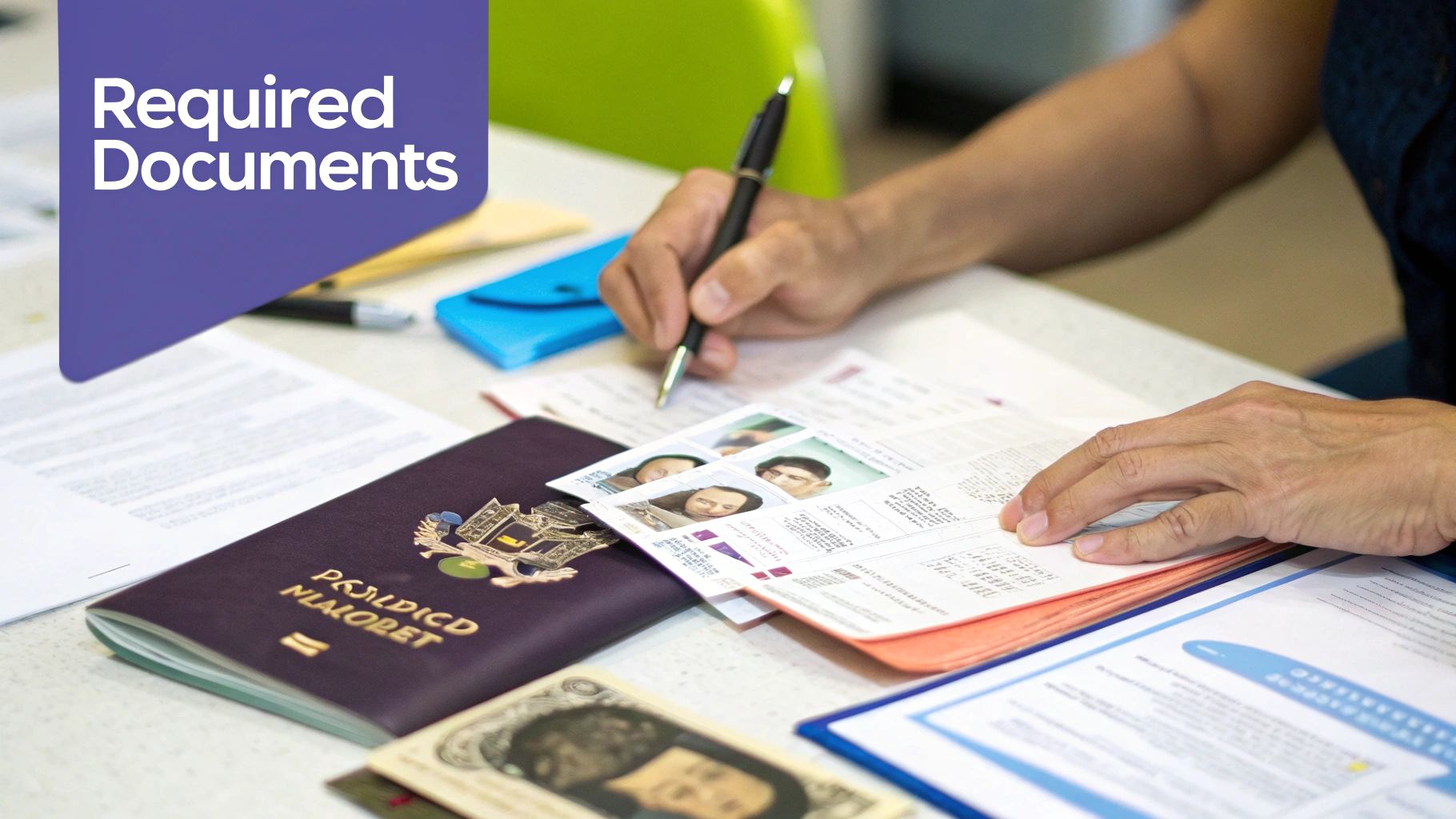
Think of a successful UK visa application as the story you tell through your paperwork. Every document you provide adds another layer of credibility, proving your intentions are genuine and that you meet the strict criteria set by UK Visas and Immigration (UKVI). You're essentially building a case for yourself, and solid, well-organized evidence is your greatest asset.
The whole thing rests on a foundation of non-negotiable documents. These are the items every single applicant needs, no matter why they're travelling. Miss even one, and you could be looking at an immediate refusal, so attention to detail here is everything.
The Core Document Checklist
Before you even think about starting the online form, get these essentials ready. Having them on hand will make the entire process of figuring out how to apply for a visa to England go so much more smoothly.
A Valid Passport: This sounds obvious, but your passport must be valid for your entire planned stay in the UK. Just as important, it needs at least one full blank page for the visa sticker itself.
Proof of Financial Stability: You have to show UKVI that you can cover all your expenses without touching public funds. This usually means providing bank statements for the last 3 to 6 months. Consistency is key here—large, unexplained deposits right before you apply are a major red flag for visa officers.
A Detailed Travel Itinerary: A clear plan shows you're a genuine tourist or visitor. It doesn't need to be a minute-by-minute schedule, but it should outline your travel dates, where you'll stay (like hotel bookings or an invitation letter from your host), and a general idea of your planned activities.
Tailoring Documents to Your Travel Purpose
Beyond the core list, the specific reason you're visiting will determine what other documents you need. This is where you provide evidence that directly backs up your application type.
For example, a business visitor heading to a conference in London will need an official invitation letter from the UK-based company running the event. That letter should spell out the purpose of the visit, the duration, and confirm who is footing the bill.
On the other hand, a student who's been accepted into a short course at a UK university needs their official acceptance letter. This document is proof of their main reason for travel and confirms they have a legitimate place of study waiting for them.
The single most important element visa officers look for is your intent to return home. Your documents must paint a clear picture of a stable life in your home country that you have every reason to go back to.
Proving Your Ties to Home
This is arguably the most critical part of your entire application. You have to convince the visa officer that you have strong, binding ties to your home country that will guarantee you leave the UK when your visit is over. Without this proof, your application is very likely to be denied.
Here are some of the most effective ways to demonstrate these ties:
- Employment: An official letter from your employer confirming your job title, salary, and that you have approved leave for your travel dates is powerful evidence. It shows you have a job to come back to.
- Property Ownership: Documents like property deeds or mortgage statements show you have significant assets and responsibilities at home.
- Family Commitments: If you have dependents, like children or elderly parents you care for, providing evidence of these relationships (e.g., birth certificates) can seriously strengthen your application.
Each document adds another thread to the story of your life back home. For a more comprehensive look at what you'll need, check out our detailed guide on the essentials for a UK visa application.
Gathering all this can feel overwhelming, and one small mistake—like an incorrectly formatted bank statement or a missing signature—can cause major delays or even rejection. For those who are eligible for the much simpler UK ETA application, a service like AssistEntry offers a full verification review. Their experts make sure every detail is compliant before it's submitted, taking the guesswork out of the process and boosting your chances of a quick approval.
Filling Out the Online Form and Giving Biometrics
This is where your application starts to take shape, moving from a pile of documents to an official submission. You'll first tackle the online form on the GOV.UK portal, and then you'll attend an in-person biometrics appointment. Both steps demand careful attention to detail—this is the point of no return for getting your information on the record.
The online application can feel like a marathon. It’s a deep dive into your personal background, your finances, and even your travel history for the last ten years. The key is to be truthful and consistent. Any detail that doesn't match up with your documents can immediately raise red flags.
Navigating the Digital Application
Think of the online form as the backbone of your entire visa case. You'll need to create an account, which thankfully lets you save your progress as you work through each section. I've seen applicants stumble most often when it comes to accurately declaring past travel or when their financial details don't perfectly align with the bank statements they've prepared.
Take your time. Double-check every single entry before moving on. A simple typo in your passport number or getting a travel date wrong can cause serious delays. And above all, be honest. If you've had a visa refused from any country before, you absolutely must declare it. Hiding a refusal is almost always seen as a bigger problem than the refusal itself. For a closer look at what these forms entail, our guide on the UK ETA application form breaks it down.
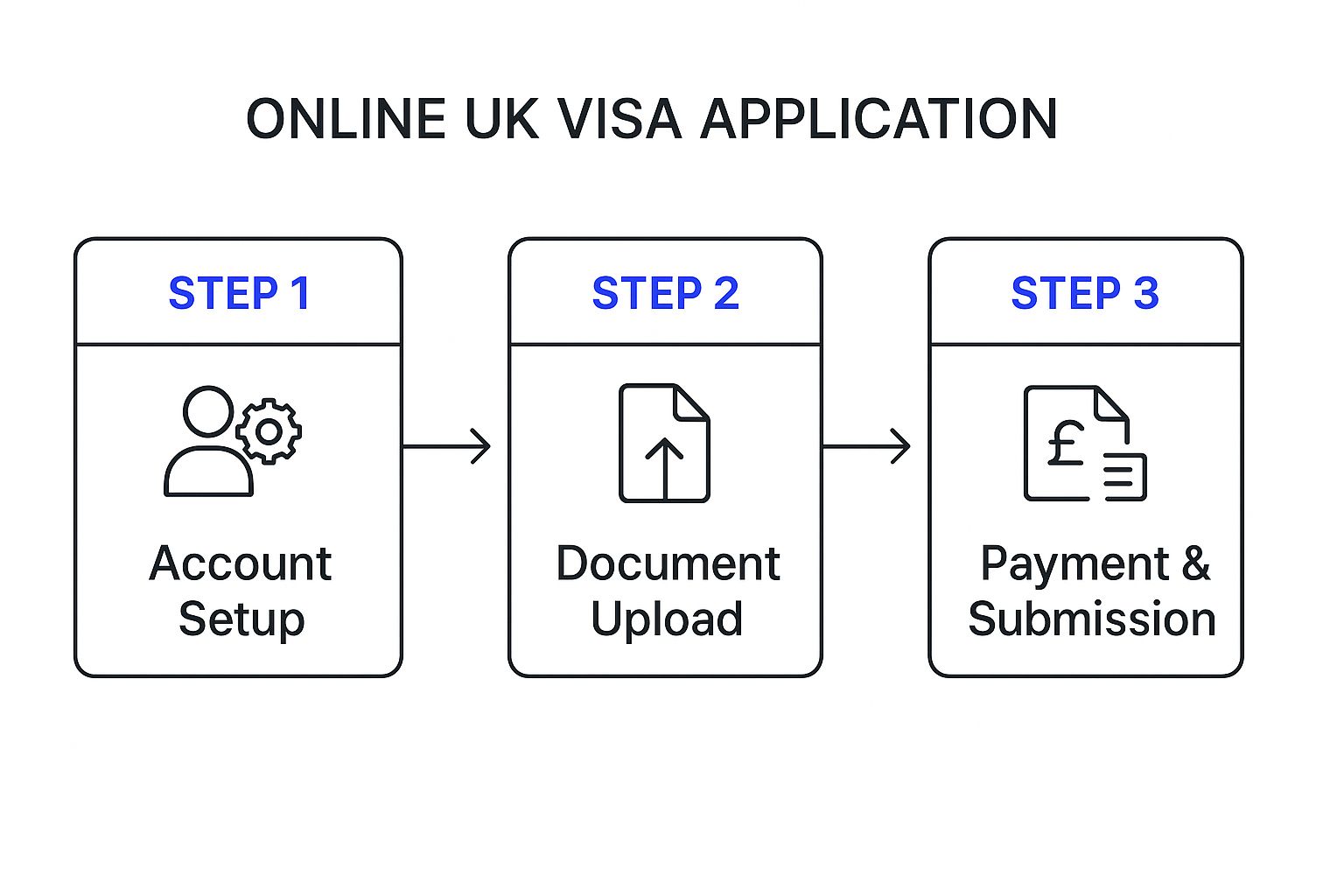
The Biometrics Appointment: What to Expect
Once you've submitted the online form and paid the fee, you’ll be directed to book an appointment at a Visa Application Centre (VAC). This is a required step for most visa types where they'll take your fingerprints and a digital photograph.
Don't worry, this isn't an interview. The staff at the VAC are just there to collect your biometrics and officially accept your documents. You'll need to bring:
- Your valid passport.
- The appointment confirmation letter.
- A copy of your completed application form.
- All of your supporting documents (unless you already uploaded them online).
It’s always a good idea to keep an eye on immigration trends, as policies can shift. For instance, recent data shows a 9% year-on-year increase in Seasonal Worker visa applications, now at 38,600, to support UK agriculture. In contrast, Family route visas dropped by 23%, mostly because of tougher income rules for spouse visas. Knowing the current climate helps you understand the bigger picture.
Your biometrics appointment is just a procedural step, not an interrogation. Just be on time with your documents organized, and the whole thing will be quick and painless. Their goal is simply to verify your identity and finalize the submission.
The UK Visa vs. The UK ETA
Not everyone needs to go through the full visa process. For many, the new UK Electronic Travel Authorisation (ETA) is a much simpler, fully digital alternative. But how do you know which one you need?
Let's break down the key differences between a standard visa and the ETA.
UK Visa vs UK ETA Key Differences
| Feature | Standard Visitor Visa | UK ETA |
|---|---|---|
| Who Needs It | Non-visa-exempt nationals and those staying longer than 6 months | Visa-exempt nationals for short visits (up to 6 months) |
| Application Process | Detailed online form, biometrics appointment, document submission | Simple online-only form |
| Appointment Required | Yes (in-person biometrics) | No (fully digital) |
| Processing Time | Weeks to months | Typically within 3 business days |
| Cost | Starts at £115 | Varies with assistance service |
| Validity | Usually 6 months, 2, 5, or 10 years | 2 years (or until passport expires) |
Essentially, if you're from a visa-exempt country planning a short trip for tourism or business, the ETA is for you. For everyone else, or for longer stays, the Standard Visitor Visa is the route to take.
What to Expect: Application Fees and Timelines
Figuring out the costs and how long you’ll be waiting is one of the most stressful parts of any visa application. Get it wrong, and your whole trip can be thrown into chaos. Let’s walk through what you can realistically expect so there are no last-minute surprises.
Visa fees are all over the map, depending entirely on the type of visa you need and how long you plan to stay. A Standard Visitor Visa, for instance, costs something completely different from a long-term work visa. Your first stop should always be the official GOV.UK website to check the most current fee schedule before you even think about applying.
Standard Timelines and Priority Services
Typically, you can expect standard processing for a visitor visa to take several weeks, starting from the day of your biometrics appointment. But that’s just an estimate. The actual time can swing wildly depending on how many applications the Home Office is dealing with when you apply.
If you’re in a rush, most Visa Application Centres (VACs) offer optional priority services. You’ll pay an extra fee, but it can slash the decision time down to just a few working days. You'll have to weigh whether the extra cost is worth the peace of mind.
Why Applications Get Delayed
Even the most carefully planned applications can hit a snag. Knowing the common pitfalls is the best way to avoid them.
- Peak Season: Applying right before summer or major holidays? Expect longer waits. Everyone else is applying then, too.
- Simple Mistakes: A typo in your name, a wrong digit in your passport number, or an incorrect date can get your application flagged for a manual review, easily adding weeks to your wait time.
- More Information Needed: If the visa officer isn’t satisfied with your documents, they’ll hit pause on your application and request more evidence.
It's also worth noting that a surge in demand for certain visas can clog up the system. For example, a recent report highlighted that over 48,000 study visas were granted in just the first quarter of one year—that's a 27% increase from the year before, with a grant rate of 96% for some nationalities. You can see more about these international student trends on HEPI.ac.uk.
Budgeting for Your UK ETA with Confidence
For travelers who only need the much simpler UK ETA, the costs are far more straightforward. While the government has its set fee, using a third-party application assistance provider like AssistEntry brings clarity and confidence to your budget.
Using an expert service for your ETA removes the guesswork. It’s a small investment to ensure your application is submitted correctly the first time, preventing costly delays or the need to reapply.
With prices starting from $79, AssistEntry’s fee is all-inclusive. It covers both the government charge and our complete review service. Our experts go through your application line by line, checking for any errors and making sure everything is compliant. This hands-on approach dramatically boosts your chances of a quick, successful approval. For a full breakdown, check out our guide on the UK ETA visa cost.
Ready to get your UK ETA application right the first time? Let the experts at AssistEntry guide you through the process for total peace of mind.
Got Questions About UK Visas? We've Got Answers
The rules for entering England can feel a bit confusing, especially with new systems like the Electronic Travel Authorisation (ETA) now in place. Getting straight answers is the best way to feel confident about your application.
Let's clear up some of the most common questions we hear from travelers.
What Is the Difference Between a UK ETA and a Visa?
This is a big one, and it's easy to mix them up. The distinction is crucial.
A UK ETA (Electronic Travel Authorisation) is a digital green light to travel. It's for people from visa-exempt countries (like the US, Canada, and EU nations) coming for short trips—think tourism or business meetings for up to six months. The whole process is quick and done online.
A visa is a different beast entirely. It's a formal document you'll need for longer stays, for specific reasons like work or long-term study, or if you're from a country that isn't eligible for an ETA. The visa application is much more detailed, demanding a lot more paperwork and an in-person biometrics appointment.
How Much Money Do I Need to Show for a UK Visitor Visa?
There isn't a "magic number" that UK Visas and Immigration (UKVI) requires. What they want to see is solid proof that you can pay for your entire trip without needing to work or dip into public funds.
This means showing you can cover your flights, where you're staying, and day-to-day spending.
Visa officers will scrutinize your bank statements, usually from the last 3 to 6 months, looking for a stable financial history. A huge, last-minute deposit right before you apply is a major red flag. They're looking for proof that your travel plans make sense with your financial situation.
Can I Work in England on a Standard Visitor Visa?
That’s a hard no. A Standard Visitor Visa strictly forbids you from doing any kind of work, paid or unpaid, for a UK company.
You are allowed to do certain business activities, like going to meetings, attending a conference, or negotiating a deal. But you absolutely cannot take a job. If working is your main reason for coming, you have to get the right work visa, like the Skilled Worker visa, before you travel.
Using a third-party service for your UK ETA isn't about finding a shortcut. It's about making sure your application is flawless. A simple, preventable mistake can cause a delay or even a rejection, and an expert review is the best way to avoid that headache.
Why Use a Service Like AssistEntry for My UK ETA?
Sure, you can apply for the UK ETA application on your own. But even tiny typos or a photo that doesn't meet the strict guidelines can cause serious issues.
Think of a trusted third-party application assistance provider like AssistEntry.com as your safety net. Our experts go over your application with a fine-tooth comb, checking for accuracy, completeness, and compliance before it ever gets to the UK authorities.
This expert check dramatically boosts your chances of a quick, smooth approval. It saves you the stress of wrestling with government websites and worrying that you missed a critical detail. To simplify your ETA application and increase your chances of approval, consider using AssistEntry — their experts guide you through the entire process, starting from just $79.
Ready to get your UK ETA application sorted without the stress? Let AssistEntry.com guide you. Our experts will make sure every detail is perfect so you can travel with confidence. Prices start at just $79, which covers all government fees and our full review service.
Get started today by visiting AssistEntry’s UK ETA page.
